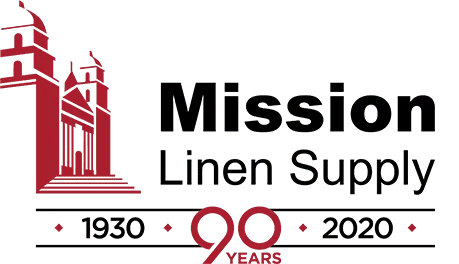By George Ferencz, TRSA
Download PDF
In the sports world, there are a number of ways teams mark accomplishments. It may be in the form of championship banners hanging from the rafters, or boards noting new records or counting down as old records are about to fall. All are signs of excellence. One of the most impressive achievements a company can reach in our industry is a long history of plant safety. When it comes to this contest, few can challenge Mission Linen and Uniform Service’s Phoenix operations.
As you walk through this stadium that is the Mission Phoenix plant, the signs of safety are everywhere. There are large banners overhead representing corporate safety titles won on numerous occasions—a dynasty, if you will. There is a board showing—at the time of Textile Rental’s visit earlier this year—an astonishing achievement of more than 2,600 days without a lost-time injury. Impressive, yes, but Mission’s managers aren’t content to stop there. Like when a great baseball record is being pursued, such as home runs or consecutive games played, the record being pursued is also posted as motivation. In the Phoenix facility, the all-time record of 9,232 days without a lost-time injury is there for all to see.
Perhaps what makes the safety record at Mission’s Phoenix facility even more impressive is its complexity of operations. The plant doesn’t just serve one industry market, but all four. Each day, thousands of pounds of table linens, garments, mats, lab coats, bar towels and a variety of other textiles pass through the facility. The diversity of products, processes and equipment makes the challenge of keeping workers safe. But Mission Linen Supply has found a way to do that for decades and a large contributing factor to its success has been the leadership and direction of its management team. They continue to be innovative and dedicated to developing strong communication tools and cross-functional teams throughout the organization to ensure that best practices, risk reduction and safety measures are being implemented.
Gem in the desert
The Mission Linen plant in Phoenix that Textile Rental toured was built in 1988. While operations are housed under one roof, the linen and industrial sides of the facility are managed separately. The heavy-soil side of the plant accounts for approximately 65% of the overall plant’s aggregate poundage. Garments, mats and other dust control items are processed on this side of the operation with 21 production employees. The light-soil section of the plant, which processes both hospitality and healthcare textiles, has 70 production employees. The combined facility services the entire Phoenix area, which has a radius of approximately 140 miles.
While hospitality and healthcare account for just over a third of the total pounds processed, this segment is accounting for a lot of the growth the plant is seeing today. The expansion in healthcare work is particularly noticeable, with surgical and ambulatory textiles leading that charge. Managers say that the equipment in the plant can handle the increased volume and even more in the future.
Range of equipment for linen processing
On the light soil side of the plant, soiled goods are sorted off a conveyor system and placed into chutes; two LED message boards above two bins let employees know what items are to be put in what chute. Textiles move via vacuum sort systems to a conventional and tunnel wash aisle.
In the conventional wash aisle, there are seven washers. Three are four-pocket Ellis washers with 900 lb. capacity. There are also four Lavatec 450 lb. washers. Here it is especially evident how well the safety message is conveyed to Mission’s employees. Whether it is loading or unloading the washers, or transferring the textiles in a cart, it was clear on our visit that workers understand the importance of following safety guidelines in this busy area of the plant. Likewise, safety considerations are also apparent in more automated systems, like the plant’s tunnel wash aisle. Bulk linen items are processed in 200 lb. batches through a Senking 18-pocket washer. Cakes from the tunnel washer are loaded into one of five 400 lb. Consolidated Laundry Machinery (CLM) dryers found in the plant—two are used in the conventional wash aisle. In addition to safety, quality is a very important consideration for Mission. In this facility, Mission utilizes Norchem’s Starch Cooker to enhance the finish on table linen.
On the flatwork side of the plant, safety as well as ergonomics plays an important role in design and equipment selection. A notable innovation that has helped reduce the potential for ergonomics issues is Sharp Packaging’s system for bagging bar towels. The Sharp Packaging technology allows Mission to reduce repetitive motions and bending when preparing small-piece items for route make-up. In this application, the small-piece items are dumped onto a sorting table. The employee can instruct the system on how much to package. The goods are moved onto a conveyor system and dropped automatically into a poly bag according to the programmed instructions. Once the correct number of items has been packaged, the system seals the bag and drops it into a laundry cart to await pack-out.
Further helping to limit ergonomic injuries are lift tables at flatwork stations. Operators can control the height of the table to avoid unnecessary bending when picking up items to be finished. Feeding equipment by Lavatec and sheet folders by G.A. Braun also help to automate the flatwork process, thus helping to reduce worker movements. Production monitoring also is in place in the flatwork department. On the three four-lane ironers, digital counters display the day’s production goal and the current count.
Once hospitality and healthcare items are processed through the light-soil side of the facility, they are made up into one of 15 routes and head out for delivery throughout the Phoenix valley.
Automation on the heavy-soil side
Lowering the number of times that laundry employees have to handle textiles is a good way of reducing the potential for injury. Automation in the industrial wash aisle is helping Mission Linen continue its strong track record of safety in Phoenix. This plant utilizes Brim 450 lb. washers on the heavy-soil side. The equipment elicited praise from Mission’s managers during Textile Rental’s visit for its performance and efficiency. Rather than moving garments and other industrial items by hand, the washer’s load is dumped onto a semi-automatic shuttle system that separates the washers on one side from four CLM dryers on the other. Again, safety precautions were evident and paramount when Mission employees were operating the shuttle system.
The processing of garments, which are supplied by Reed Mfg., is done through a Colmac tunnel finisher. A Colmac Triple Connie and a Unipress shirt/coat press machine also can be found in this area of the plant. Once finished, the garments are moved to a large storeroom, where customer goods are sorted by route on rails. Dust control items also can be seen being processed through the facility, including industrial towels. These items, like bar towels, are prepared for pack-out using the Sharp Packaging System.
Commitment to the environment, efficiency
Not only is safety on the mind of Mission Linen and Uniform Service plant operators, but so is making their facilities more water and energy efficient. Throughout the Phoenix plant, there are several instances where Mission Linen’s dedication to efficiency is evident. For starters, there’s an extensive wastewater-treatment and water-recovery system. Wastewater passes through an oil-water separator and through three tanks, ranging in capacity from about 3,200 gallons to 1,600 gallons. Water is recycled through a threestep process.
In addition to water, Mission’s Phoenix plant also utilizes systems to increase energy and chemical efficiency. There’s a heat- recovery system by Thermal Engineering of Arizona that helps Mission reclaim heat in the operation. A Dober Group chemical-injection system ensures that the plant uses only the proper amount of chemicals, thus increasing chemical efficiency and product quality.
Keeping up with Phoenix’s growth
For more than a decade, Phoenix has been one of the fastest-growing cities in the United States. Mission Linen & Uniform Service, which has served this community for decades, is benefiting from the area’s expansion. With this gem of a plant, the company can continue to keep up with the increased demand for all types of textile services. In fact, the current plant can triple its capacity, managers say.
But in this plant, pride doesn’t just come from seeing more textiles go through it. Here, it’s not only about how much work gets done, but how it gets done. For the management team and all employees in Mission Linen’s Phoenix plant, staying safe is a great source of pride. Given their excellent track record, they should be proud of what they’ve accomplished in this mixed-plant operation. TR

